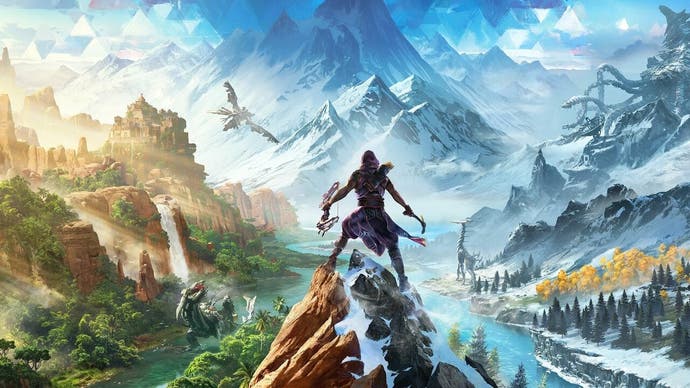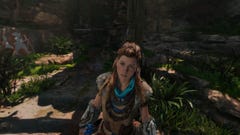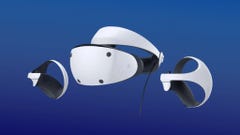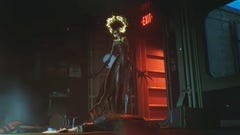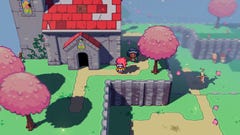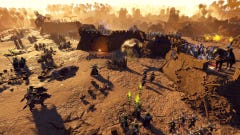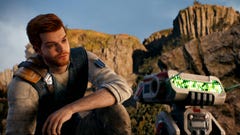Horizon Call of the Mountain review - a visually spectacular introduction to the PSVR2
Feast Horizon this!
I've seen some fine views in my time on this planet. The Mavora Lakes in New Zealand, the Tokyo skyline, the reflection in my bathroom mirror of a morning... They're all beautiful and memorable sights in their own right, but when it comes to video games, I'm pretty sure Horizon Call of the Mountain delivers some of the greatest virtual vistas I've ever witnessed.
For many of PSVR2's early adopters Horizon Call of the Mountain will not only be their first experience of Sony's new headset but perhaps VR in general, and what an experience it'll be. There were times during Firesprite and Guerrilla Game's collaboration where I was simply boggled by how beautiful it all was; where panoramas of distant waterfalls and snowy mountains wrapped in the wreckage of long dead machines took my breath away, and where lush forests and glittering rivers made me forget the real world beyond my headset.
Aside from maybe Kayak VR: Mirage, I don't think I've ever played a VR game with visuals as gorgeous as this one. So it's a shame then that the world and mechanics propping it all up are distinctly average. In between the 'wow' moments (and don't get me wrong, there are plenty of them), I just couldn't help but feel slightly bored.
In Call of the Mountain you play as the internal monologue of Ryas, a man so uninteresting I soon learnt to tune his voice out until it became nothing more than an annoying hum in the background somewhere. Fans of the Horizon series will find lots to enjoy about the story and the way it links in with the main games, but for people like me who were left cold by the interactions in the mainline Horizon games the story in Call of the Mountain is by far the weakest part of the game.
In between levels, NPCs spouted incomprehensible lore at me for lengthy periods while I was locked in place unable to move anything but my arms and head, a pet peeve of mine when it comes to VR immersion. On the plus side, it's a great opportunity to try the Sense Controller's finger-tracking with which I was able to flick the V at everyone who spoke to me. I don't know what a 'Shadow Carja' is, but I lost count of how many times I was called it by someone who was either angry and/or disappointed in me.
Call of the Mountain is first and foremost a technical showcase for what's possible with PSVR2, and in that regard it's much more successful. Thanks to the 4K HDR Display of the PSVR2, the colours are crisp and vivid and the detail on distant objects is as sharp and in focus as anything close by, and I think this is going to be one of the things that most impresses people who have only ever played the original PS VR before. In the original low resolution headset, anything past about a metre away from your face becomes fuzzy and blurred and the colours become muddy, but here the contrast is striking. The clarity of the image and the depths of the colours create a believability to the world that makes it feel way more alive than anything the original PS VR could manage.
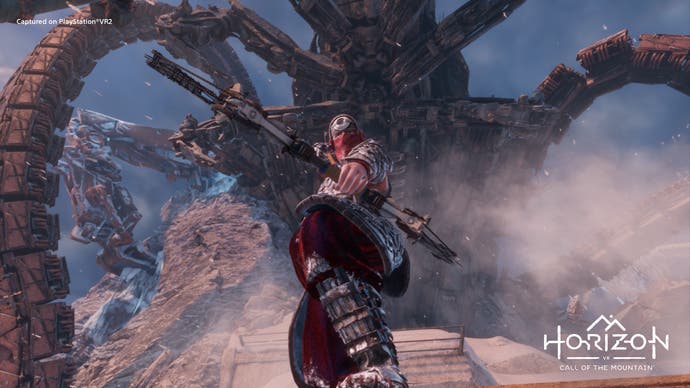
The visuals aren't always perfect though; thumbstick turning makes the world jitter noticeably, which might be due to the amount of detail on show given how it's not evident in more modest games like Star Wars: Tales from the Galaxy's Edge or Jurassic World Aftermath. On the odd occasion I'd spot textures loading in out of the corner of my eye, which I'm guessing is something to do with the PSVR2's eye tracking which renders objects you're looking directly at in greater detail than those in your periphery, but these pop-ins were hardly obtrusive to the experience.
Eye tracking, or 'Gaze Tracking' as it's called in the game actually helps to improve the immersion of the game in a variety of little ways and even to select options and browse menus, but I think the best way is how NPCs can directly look you in the eye as they speak to you (or in this case insult you), it makes them feel incredibly human.

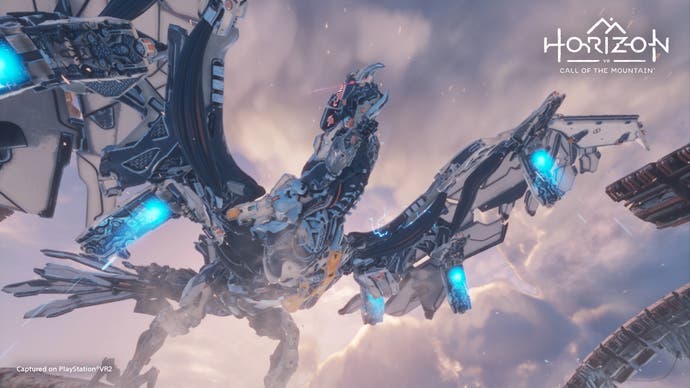
As a showcase Call of the Mountain has also been designed to cater to the broadest range of VR experience levels as possible, something it does well. There's a variety of control schemes and comfort settings to play around with and the action ramps up so gently that it's hard to be overwhelmed by anything other than the visuals at first.
One thing that struck me as strange, though, was how fighting colossal robotic dinosaurs - surely the coolest thing you can do in the world of Horizon - has been kept to a minimum. Call of the Mountain is less about tackling titanium T-Rexes and more about climbing up a mountain before soaking in the view. I'd say that there's about 70 percent climbing and 30 percent fighting robo-dinos in this game, something that's likely going to disappoint a fair few people.
That's not to say the climbing isn't fun, and you're regularly given you new tools to add a bit of variety to the way you climb while there are some incredibly cool structures to clamber over. Even so, the reliance on climbing sections over everything else does get rather repetitive and I felt myself longing for a bit of combat instead of another huge section of upper torso-powered traversal.
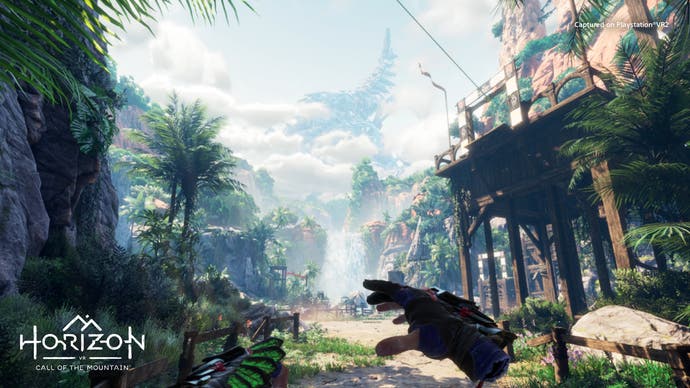
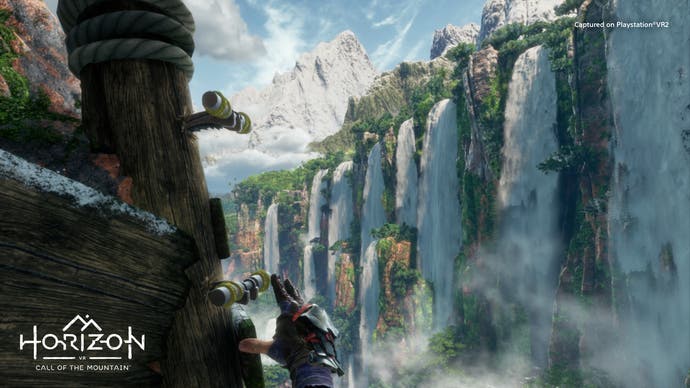
Thankfully all that repetition feels relatively effortless due to the accuracy of the Sense Controllers. Those things really are a step beyond the clumsy, untrackable Move Controllers of old and they made scaling even the mightiest of peaks a doddle. There's some gentle haptics in there too, which help to give you the feeling of gripping and pulling yourself upwards but they are a bit subtler than I thought they'd be. This is especially true of the haptics built into the PSVR2's headset, which I feel Guerilla and Firesprite may have dialled down a bit since I played the game in preview. In an early section a Stormbird flies right over your head and in my preview, I remember my head vibrating like a jumbo jet had passed me by, but in the retail version this moment barely tickled my scalp.
There are plenty of distractions littering each level; things like musical instruments or hammers to smash pottery with, or areas where you can indulge in a bit of cave painting or rock balancing. None of these have any relevance to your story, but it's nice to be able to pause every so often and just have a bit of a play around in VR and test the fidelity of the Sense controllers. There's so much physicality to this world and many things you can see can be picked up, thrown, played with and hit against each other in a realistic manner.
One of the more controversial talking points about Call of the Mountain is the on-rails nature of its combat. In what I presume was a move to not overwhelm new players, combat takes place on rails and your movement is limited to either slow strafes or quick dodges as you circle your enemy. It feels limiting at first, especially to VR veterans who cherish freedom of movement, but once you get into the swing of firing your arrows and dodging left and right, the battles against these massive mechs can be thrilling. I enjoyed the fights where Call of the Mountain threw three or more smaller enemies at me at once way more than I did the big spectacle battles with things like the Thunderjaw.
It is possible to fight these machines with traditional free movement if, like me, you biff up one of the game's many stealth sections. In one area I had to make my way through some tall grass that was overlooked by three Watchers, but I bumbled out of the grass at the wrong moment and alerted them all at the same time. I was surprised then that, instead of the sequence restarting, I was able to then attack them with no limitations to my movement at all. I couldn't do the speedy dodge you're given in the on-rails sections and Ryas' movement speed is a bit sluggish in general, but fighting the machines in this way was still very manageable and it made me wish for a sequel where the player is trusted with a bit more freedom.
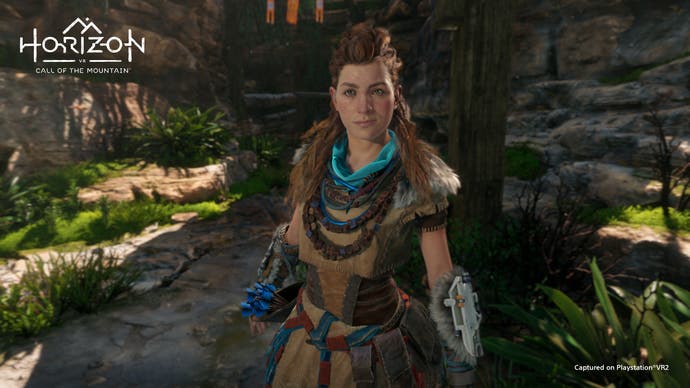
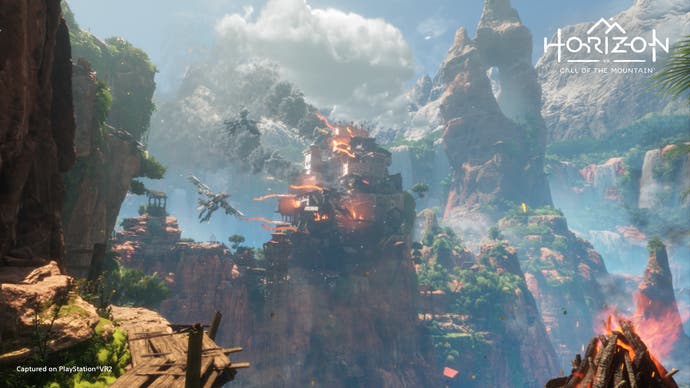
Aside from the roughly seven hour long main campaign, which has enough side routes, hidden areas, collectables and of course, gorgeous vistas, to be worth an extra playthrough, Call of the Mountain also has a couple of extra modes that are unlocked as you progress through the game. The first of these is a five minute 'safari' where the games' opening chapter is retooled into a gentle theme park ride where you watch machines hunt and fight and fly about from the safety of your kayak. It's hardly worth the cost of entry, but is still a genuinely cool little experience and the perfect place to put a curious family member who has never played VR before. Alongside that there's also a little training hub area where you can go to test your aim or climbing skills and compete against scores set by some of the characters you'll meet in the game. It's basic but fun and it's a nice place to hang out (sometimes literally) if you fancy dipping into the world without the pressure of following the game's narrative.
In flat-screen, Call of the Mountain would have been nothing more than a forgettable spin-off with a limited appeal to anyone but the core Horizon fans who know the difference between a Nora and an Oseram. With the addition of PSVR2 though, Horizon Call of the Mountain becomes a remarkable spectacle that anyone can enjoy. Sure the mechanics and story are lacking at times, but none of that is going to matter so much when you get to experience the intoxicating views this world has to offer.
